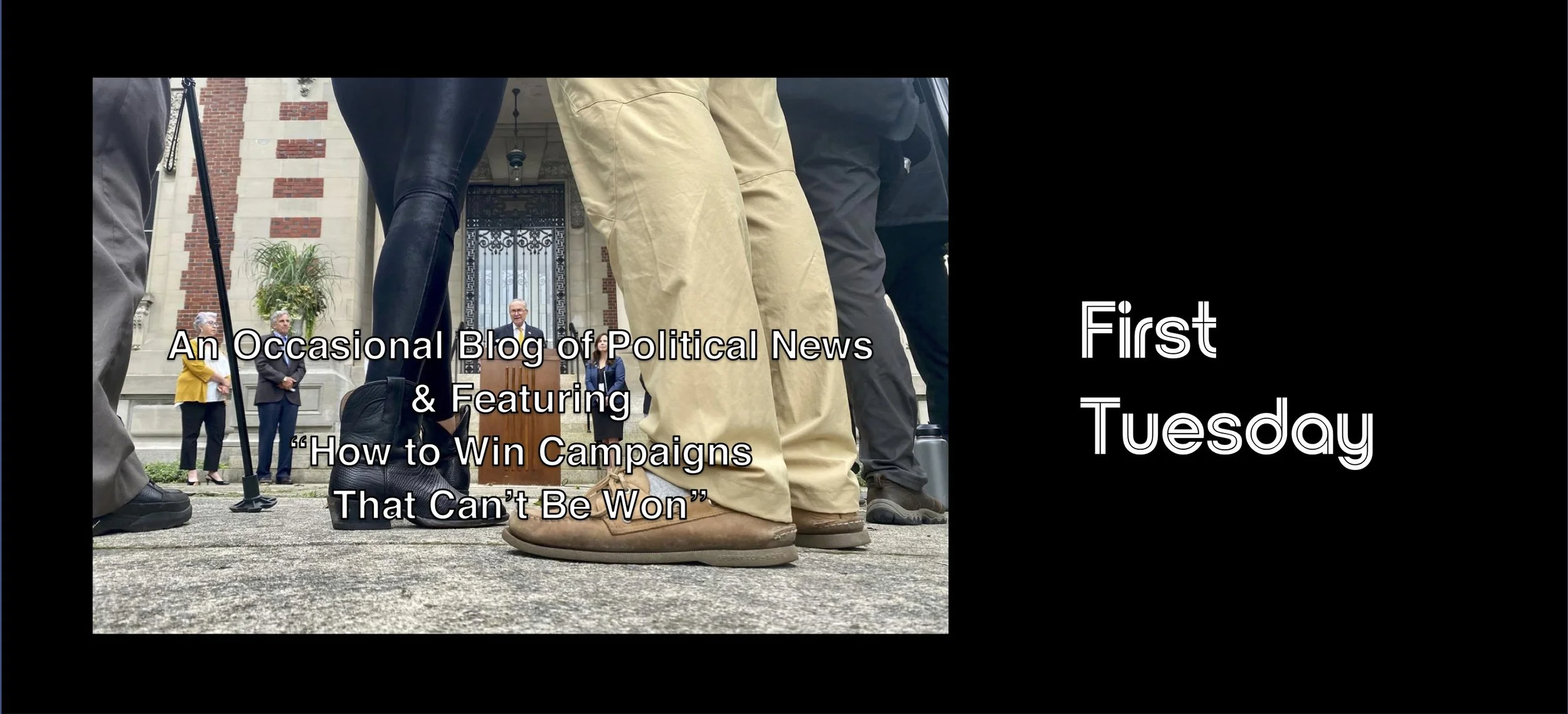My 6 Rules for Creating a Strong Message
/Rachel may and her daughter at the moment she realized she won. (Photo by the Author)
“Too many progressives make the mistake of believing people are galvanized around ten-point programs. They are not! People respond according to their sense of right and wrong. They respond to a leadership of values.”
-- Paul Wellstone
There is one common thread that weaves through all the winning campaigns I’ve worked on. The candidates had a reason to be running and they were willing to tell voters where they stood on the issues. It isn’t enough to just want to be involved. You have to be able to contrast yourself from the person you’re running against and consequently, give voters a reason to vote for you.
That’s where messaging comes in. You need a theme for your campaign. And, the message that convinces voters that you’re the one who can bring it home.
You’ll get your message out in several ways including (in no particular order):
Candidate’s Website
Facebook Page and regular postings
Facebook ads
Local newspaper/shopper print ads
Instagram
“X” (formerly known as Twitter)
Letters to the editor of local news outlets
Direct Mail
Text messages
Local appearances and Elevator Speech
In 2019, now New York State Senator Rachel May, long-time progressive activist in New York’s 48th Senate District and a newcomer as a candidate, ran for New York State Senate and won.
She took on a formidable incumbent. Senator David Valesky was a 14-year veteran with a war chest the size of Fort Knox. He was a Democrat, but vice-chair of what was called the Independent Democratic Conference. The IDC as it was known was a group of Democrats who (some say at the behest of then Governor Andrew Cuomo) sided with the Republican minority in the Senate to support conservative legislation.
This infamous group included eight members who stopped the passage of several pieces of important progressive legislation. But had unlimited resources and the advantage of incumbency.
He was impossible to beat.
Yet, the 2019 election saw six of the eight IDC members lose their elections …. And Mr. Valesky was one of them.
Rachel May won because she had a reason to beat the other guy. She won because she had a message. She won because she put in the hard work necessary to get that message out to the voters.
Here’s a link to her elevator speech which is among the finest I’ve ever seen.
As you create your own theme and message, here are a few thoughts to help you along.
Rule # 1: Be For Something … Not just against someone.
When Republican Elise Stefanik was running for re-election in New York’s 21st Congressional District, several excellent progressive Democrats flocked to run against her. Stefanik had yet to show her true colors and was elected as a moderate. But slowly, she began to see which side her bread was buttered on, and slowly aligned herself with Donald Trump. There was a highly contentious primary among Democrats and the winner had great qualifications.
But, seeing Stefanik start to move to the right, her Democrat challenger chose to craft a message about the Congressmember’s politics and not the issues important to the voters in the district. She shunned the endorsement of progressives like the Working Families Party which would have helped define her as a viable alternative.
Her message never resonated because it wasn’t clear what she was for, only who she was against.
Your campaign theme and subsequent messaging should be about what you believe.
Your messaging must address the issues important to the voters you’re trying to reach.
You have to illustrate a contrast between yourself from your opposition.
The point here is that she lost because she ran AGAINST someone … not FOR something.
RULE # 2 – Contrast Yourself from Your Opponent.
If you’re running against a Republican, and you’re messaging appears to say that you are “Republican Lite”, voters will choose the REAL Republican every time. Choice Matters.
A great progressive from the North Country became a candidate for NYS Senate at the last minute, and a dedicated group of liberal folks I know spent 10 long, grueling days getting her 2,000 signatures to qualify for the ballot. There were (and still are) a ton of people who don’t have proper medical insurance coverage in that area and her main theme while collecting signatures was the need to elect someone who would support “Medicare for All”. Within a week after her place on the ballot was secured, she recruited a Campaign Manager who happened to be connected to the insurance industry. He quickly convinced her to drop the issue. When I asked her about it she replied, “I can’t say that, no one will vote for me.” And, she turned into “Republican Lite”.
She was right about one thing. No one did.
Remember:
You need to compare and contrast yourself with your opponent.
The only thing that makes “Lite Beer” a beer is that it comes in a can. True beer aficionados won’t touch the stuff. “Republican Lite” Democrat candidates will not convince any Republicans to vote for them, and they’ll lose the support of their Democrat base.
Make sure your message would make you vote for yourself.
Rule # 3 – Like the State Lottery “Pick 3”
Look to the people you know and respect to determine the issues important to voters in your district. Has the neighborhood been victim to Amazon Pirates stealing packages from doorsteps? Has crime become rampant? Is there a lack of sidewalks along busy streets? Attend the board or legislature meetings and listen to what people are saying. Determine what the issues are and pick the top three that conform with your theme.
Remember:
Just like Goldilocks. 2 issues is too cold. Ten issues is too hot. But three issues is just right because people REMEMBER THEM.
Once you’ve chosen the issues that resonate with your district, take the time to craft them into a simple message. Hammer them out. Spin them. Make them the core of your elevator speech. Then say them over and over and over again. And don’t change issues mid-campaign because you got bored with them.
The only one I know who had a ten-point program was God with the Ten Commandments and look how THAT’s turning out.
Rule # 4 – Make it Personal Tell Stories About Yourself
Everyone is going to need an Elevator Speech The name comes from the notion that the speech should be delivered in the short time period of an elevator ride, usually 20-60 seconds.
It may not be 60 seconds but in the words of my friend Malik Evans who is now Mayor of the City of Rochester who said, “Be Brief Brother, Be Brief”. Connect with your audience.
Know your personal story and understand how your story informs your politics.
Understand and articulate your core values and beliefs.
Be clear about your motivation. Answer the question, “Why do I want to run?” And does the message make me want to vote for me.
Make sure you ASK to take action. Compel them to join with you. Ask them to vote for you because you are the obvious choice. State the problem…. And demonstrate how you are the solution.
My Rule # 5 -- “When All Else Fails, Tell the Truth
A famous politician once said. “When you are taking a controversial position if you believe it and you argue it, you can convince enough people that even if they don’t agree with you, they’ll appreciate that you stand for something.”
Don’t Lie. Please. And, don’t be afraid to tell the truth.
If you’re going to say something just to be elected you shouldn’t be running.
Avoid saying, “Let me be honest with you”, it subtly makes people wonder if you weren’t being honest at a prior time.
Say what you believe.
Rule # 6: Once you have your message say it over and over again!
You probably don’t like boxing but I do … or used to. Cause I’m old. Here’s a link to a story about a famous boxing match between Mike Tyson and Evander Holyfield as told by James Carville. It’s the best example of how to remain on message I’ve ever read.
It’s from the book he and Paul Begala wrote called: Buck Up, Suck Up and Come Back When You Foul Up Simon & Schuster p. 124 Repitition under fire
Staying On Message
Remember:
Stay on message.
Remember, just because someone asked you a question, doesn’t mean you have to answer it. Stick to your message.
If you don’t want to believe me, believe James Carville. He got Bill Clinton Elected President

